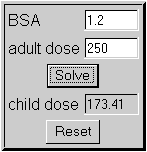|
|
Example
The doctor has ordered an antibiotic whose average adult dose is 250 mg per day. What would the dosage for this medication be on a child who has a length of 120 cm and weight of 40 kg?
First you must determine the BSA. One method method is using the West Nomogram.
Using a straight edge (such as a ruler or piece of paper), align the straight edge so it intersects at the child's height and weight. Doing so will create an intersection in the BSA scale [show me]. The boxed in scale is to be used only if the child is of normal height and weight.
Next, enter the BSA value of 1.2 (determined from nomogram) and the adult dose of 250 into the calculator.

In this example, 173 mg of medication would be given.
Formula*
| BSA | x adult dose = approx. child dose |
| 1.73 |
*Gerald, M. C., & O’Bannon, F. V. (1988). Nursing pharmacology and therapeutics. (2nd ed.). Englewood Cliffs, NJ: Prentice Hall Incorporated.
Note: This web page is intended for educational purposes. Do not use for clinical use. This information is intended for nurses and nursing students. Information on this page reflects current teaching practices of accredited schools of nursing. Be aware more accurate methods of pediatric dosing exist. Only persons licensed in administering medications may give medications. Also, not all drugs that are safe on adults may be given to children due to differences in physiology. Pets likewise do not share the same physiology as humans.
|
manuelsweb.com |